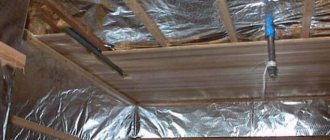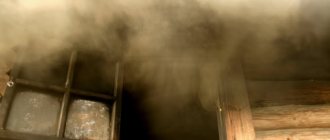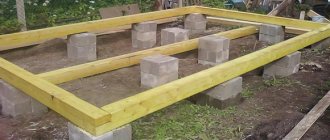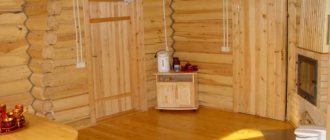Installing a shower in a bathhouse with your own hands is not an overly difficult task. However, the work has its own nuances that should be taken into account.
First of all, a shower requires cold and hot water. And if, as a rule, there are no problems with cold, then you will have to tinker with hot.
>
There are several options for obtaining hot water, from an electric heater to a gas boiler. In this article we will look at one of the simplest solutions for arranging a shower in a bathhouse.
The photo shows a shower stall installed in a bathhouse.
Shower in your bath
A bathhouse with shower and toilet can be of two types:
- Autonomous. This design is very cheap to install and is most often built by summer residents, intended for seasonal use. This is a barrel bathhouse with a shower, when the water supply comes from a tank installed on the roof of the building.
Ideally, such baths use a metal tank, which is heated by the sun's rays during the day, and by the evening you can take a warm shower without using any heating systems.
- Connected to a water supply. Such a ready-made bathhouse with a shower can be used all year round, since the water is heated here using a heater. In this article we will look at both options.
Making an autonomous shower
We install the drain.
Installing a shower in a bathhouse in this way is within the power of any home craftsman. This is the oldest option for arranging a shower, which is still in great demand today.
Installation is carried out in several stages:
- Not far from the bathhouse, we dig a drainage hole where water will flow.
- We lay a plastic pipe under the floor of the bathhouse, one end of which should go into the pit, and the other should be connected to the drain hole in the floor.
- In a sheet of galvanized iron, cut a hole corresponding to the size of the drain pipe.
- We stuff a sheet of iron onto a wooden floor, and coat all its joints with silicone.
- Place a cement screed on the floor. To do this, we first lay a thin reinforced mesh on a sheet of iron. The main thing in the work is to observe the slope towards the drain.
- We lay porcelain tiles on fresh cement, and treat all seams with silicone.
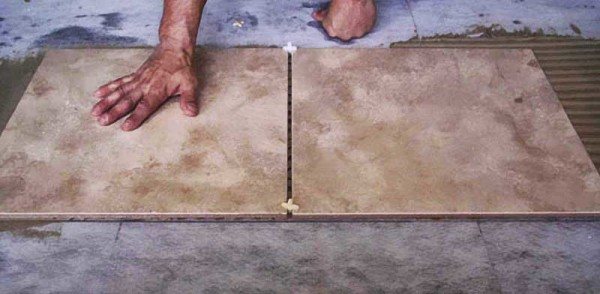
Laying the tiles.
- At the top of the column you need to install an asbestos-cement pipe with a diameter of 10 cm. The length of the pipe should be sufficient to lead it out through the roof.
- We step back a little from the top of the column and make a slot in the pipe, inserting a valve into it.
- We install a water tank on the roof. All the work of the shower is carried out due to the pressure of the water in the tank.
The photo shows a flat tank installed on the sauna roof.
Using an electric heater – sauna all year round
If you want to equip a permanent shower, then you should ensure a constant flow of water and heating. The easiest way to set up a bathhouse with a shower in the country is using an electric heater.
They come in two types:
- Flow-through. An excellent option, characterized by low price and ease of DIY installation. However, such devices are very demanding regarding the stability of the electricity supply and water pressure.
Advice! Good water pressure can be achieved by installing a pump. But the problem with voltage instability outside the city appears quite often.
- The storage heater can function normally even with significant voltage drops. The disadvantage of such equipment is its considerable size. The more water such a heater can hold, the larger it is.
Storage water heater.
Advice! The problem with the dimensions of the heater is solved by installing it in the attic of the bathhouse.
Selection, installation and alternative
To begin with, it should be mentioned that there are many ways to solve the issue of supplying hot water to a building. In this case, the simplest methods are to install a separate heater or use a stove for these purposes (see also the article Design of a stove for a bath: features).
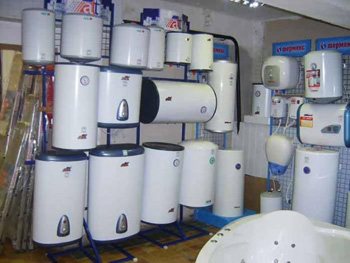
Considering the large assortment of such products, the choice must be approached very responsibly, based on the technical conditions of the bath
Selection and installation
- Typically, low-power electric water heaters are used for such premises. This is due to the fact that before the steam room reaches its operating mode, the water in the device will gradually heat up. This choice will allow you to significantly save on maintaining the required temperature.
- You also need to remember that if water heaters for a bath are installed next to a steam room, they will be constantly exposed to moisture. Therefore, professional craftsmen advise not only to pay attention to the technical characteristics of the device, but also the quality of its protective coating.
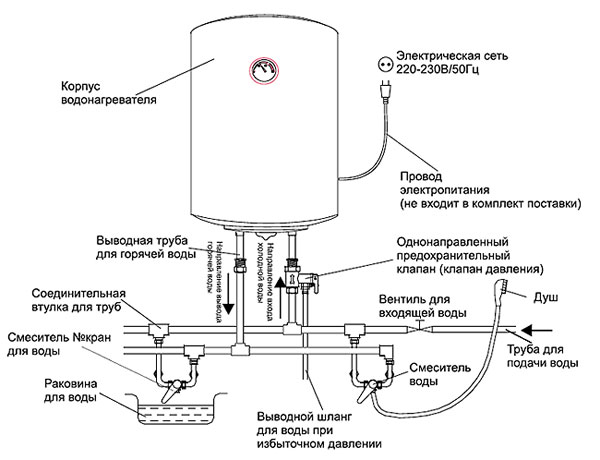
Installation and connection diagram of the boiler with wiring system
- The capacity of such products is determined by the number of people for whom the room is designed. However, most craftsmen advise installing large-volume boilers so as not to lack water and not save on it.
- To connect, these bath heaters need a pipe system that would supply cold water and remove hot water. Given this feature, it will be necessary to install plumbing in the bathhouse.
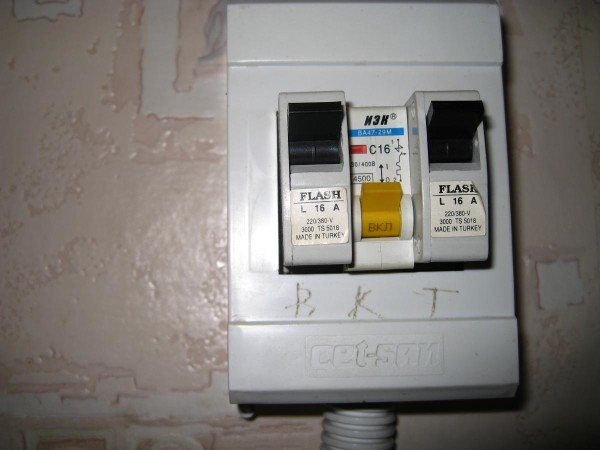
A separate machine should be installed for the heater
- Special attention is paid to the power supply of the device. The fact is that an electric heater is a fairly powerful consumer of energy. Therefore, it is worth using a separate cable for it, which is powered at the distribution panel through a dedicated circuit breaker.
- The protective cover that covers the wire terminals on the heater must have an airtight seal. If it is missing, then you can make it yourself from a piece of rubber or by filling the space with silicone.
Advice! Each similar product has its own installation and operating instructions, recommendations and requirements, which should not be violated. Otherwise, you may damage the device or significantly reduce its service life.
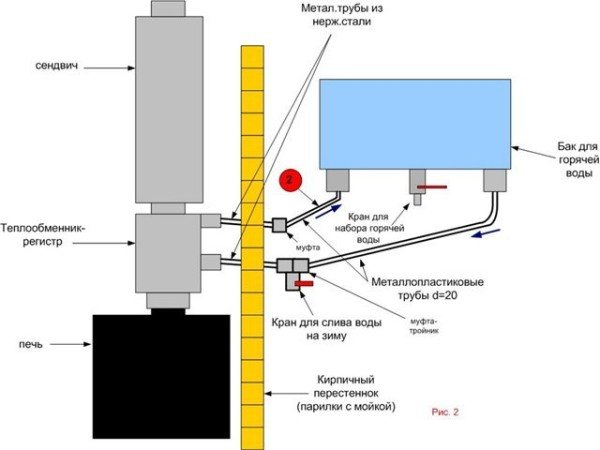
Using a stove to heat water in a separate tank
Stove heating
The simplest method is to heat the water using the oven temperature. To do this, place a container with liquid on it, which is separated from the firebox by a small metal wall. As a result of this design solution, the water heats up quite quickly and can even reach boiling point.
However, if the steam room is made on the principle of a sauna, then the instructions for its operation do not imply the presence of wet steam in the room. Therefore, such stoves cannot be used, which means it is necessary to look for an alternative to heating (see also the article Steam room in a Russian bath: how to do it yourself).
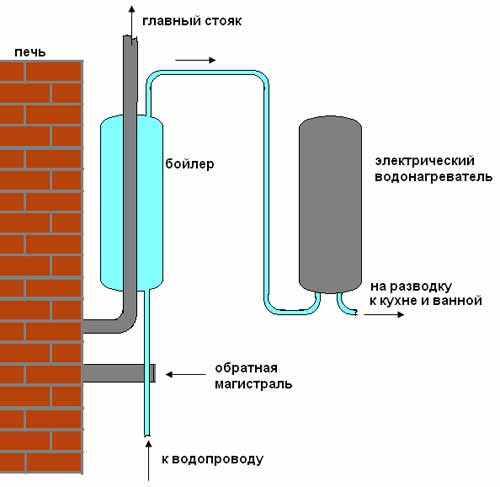
Combined system using furnace and boiler
To solve this problem, professionals advise using fireboxes with a remote tank. In these systems, a small container or spiral of pipes is installed in the oven. It is connected to a tank in another room at different levels.
As a result, water from the furnace will flow under pressure and temperature into a common container, and from there the cooled liquid should flow back into the firebox. Such a water heater in a bathhouse is very similar to the principle of operation of a gas water heater, but only without the intense impact of fire. Therefore, it can be considered safe and quite effective.
Advice! Such water systems are the most economical and are made in the best traditions of bath culture.
Another combined system using two tanks
Flow heaters
These devices also operate on electrical energy, but at the same time heat running water. They do not require a long time to reach operating mode and function effectively from the moment they are turned on.
However, the price of such products is quite high, since cheap models are quite impractical and quickly break down. It is also worth noting that they have a fairly high energy consumption, which is not very economical.
The fact that these types of devices usually serve one consumer point also deserves special attention. They are not able to control the entire system.
Advice! When installing such a device, special attention must be paid to the power cable. The fact is that this equipment is quite powerful and requires conductors of the appropriate cross-section.
A dedicated flow-through heater that is often manufactured with single point service in mind
Installing an electric heater
Before you make a shower, you should consider several nuances in installing the heater:
- First, we supply electricity. To power a heater with a power of 30 kW, it is necessary to purchase copper wires with a cross-section of at least 2.5 mm.
- Since the electric heater is in constant contact with water, the possibility of a short circuit in the device cannot be ruled out. Manufacturers solve this problem by grounding. In order to provide additional protection against electric shock, you should install a separate batch machine on the power supply line.
Ideally, this should be a special machine that provides protection against short circuits.
Instructions for supplying water to the heater:
- For flow-through heaters, the circuit is extremely simple.
Since such devices cannot supply several water points, cold water supply is simply supplied to them.
- You can use any pipes, including plastic ones.
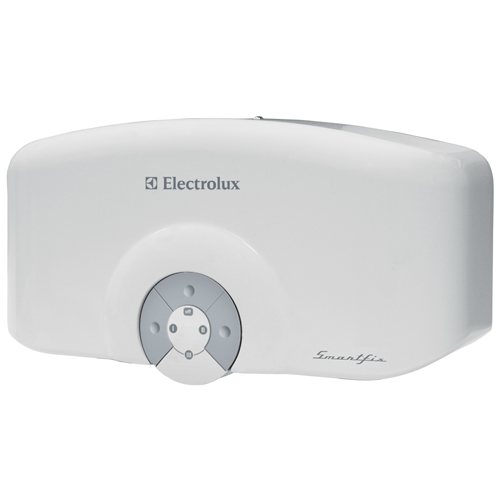
Electric instantaneous water heater.
- In order to prevent the accumulation of large amounts of rust in the heater, it is necessary to equip it with a mechanical filter.
- Install an intermediate valve to be able to turn the water supply to the instantaneous heater on and off.
- Storage type heaters have a more complex connection scheme to the water supply. In this case, the water is heated to a temperature of about 75 degrees. Therefore, when connecting, you must use a mixer. Also, storage heaters can be used for several water points, which significantly complicates the work of laying the pipeline.
What you need to know about plumbing first
All this makes you think not only about the need to install plumbing in the bathhouse, but also about what types of plumbing fixtures are best to choose and how to install them correctly with your own hands.
Current repairs of plumbing equipment, which sooner or later will become inevitable, are also of considerable importance. Currently, plumbing is not only a convenient means of using water, but, in many cases, it is becoming an integral part of the interior and design of bath rooms. Therefore, when buying plumbing fixtures in a store, you should pay attention to the following main characteristics:
- Quality;
- Ease of use;
- Functionality;
- Method of connection to the sewerage and water supply of the bathhouse;
- Design;
- Manufacturer;
- Price.
Of course, before you start installing plumbing, it is necessary that the bathhouse has a reliable source of water supply, the pipelines of the water supply and sewerage systems have been laid, and the wastewater drainage has been properly carried out in accordance with the sewerage requirements.
up

